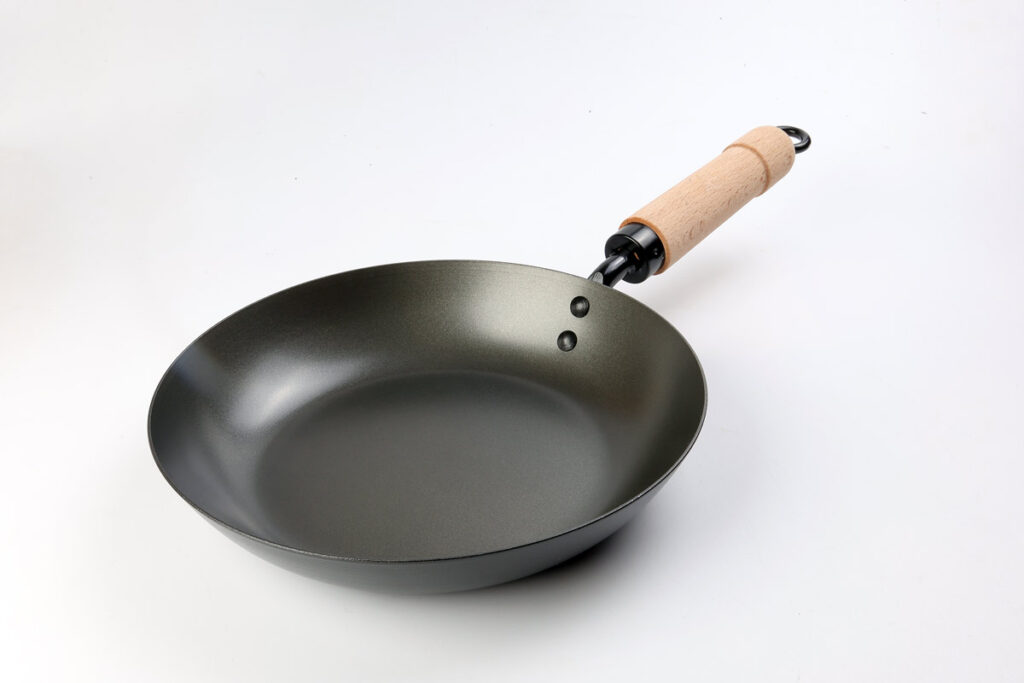Chicken Sausage Skillet Dinner Recipe, Spotlight on Fennel, Wok—A Stovetop Essential, Add Spice for Portion Control, and Mindfulness and Step-tracking Boost Motivation
I love a meal that comes together in one pot with ingredients that create a yummy sauce. I’m using chicken as a change from pork sausage and checking off all the boxes by combining it with fresh peas and new potatoes. There’s also a reason for the sprinkle of peperoncino—a study showed that chili peppers can help you eat less while still feeling satisfied. And if you’re looking for added motivation to get involved in warm-weather activities, there’s an app that can help.
Chicken Sausage Skillet Dinner
 Chicken Sausage Skillet Dinner
Chicken Sausage Skillet DinnerParboiling the potatoes cuts the cooking time of this flavorful dish. The recipe makes a delicious dinner, but it’s also great for a picnic since you can enjoy it at room temperature—for safety, remember to consume hot or cold foods within an hour of taking them off the stove or out of the fridge. Note: If you can only find chicken sausage links, simply squeeze them out of their casings and into the hot pan.
Ingredients
- 1 pound fingerling or new red potatoes
- 3 tablespoons extra virgin olive oil, plus more for drizzling
- 1 pound chicken sausage
- 1 teaspoon fennel seeds
- 1/4 teaspoon peperoncino (Italian red pepper flakes)
- 1 cup homemade or low-sodium store-bought chicken stock
- 1 cup freshly shelled green peas
- 1 cup freshly grated Parmigiano-Reggiano, divided use
- Freshly ground black pepper to taste
Directions
Step 1
Parboil the potatoes in salted water for 10 minutes; drain. When cool enough to handle, cut them in half.
Step 2
Heat a large flat-bottom wok over medium heat. When hot, add the olive oil and the chicken sausage, breaking it up with a wooden spoon and stirring until the meat is opaque and cooked through. Add the fennel seeds, peperoncino, and potatoes and sauté with the chicken until the potatoes crisp.
Step 3
Add the stock and use the spoon to release any bits of fond on the bottom of the pan. Raise the heat and cook down the stock until reduced by half. Add the peas and half the Parmigiano-Reggiano, stirring constantly (the sauce will thicken as the cheese melts).
Step 4
Off the heat, add black pepper to taste. Top each portion with more Parmigiano-Reggiano and a drizzle of olive oil.
Yields 4 servings

Healthy Ingredient Spotlight
Fennel Seed
Members of the Fresh-Pressed Olive Oil Club know that I’m a fresh fennel fan, but I also love fennel seeds, harvested from the plant’s flowers and then dried. While they’re ubiquitous in Italian pork sausages, they’re not always included in chicken sausages, so I’ll simply add them for their distinctive light licorice taste. Part of the same family as anise, fennel is more subtle.
Delicious in pork dishes, fennel seeds are also a great addition to summer potato, seafood, and pasta salads. When shopping, look for fennel seeds that are a pale green, not grey or brown, for freshness. If a recipe calls for ground fennel, simply pulverize them in a spice or coffee bean grinder.

Quick Kitchen Nugget
Wok: A Stovetop Essential

Did you know that a flat-bottomed wok can lead a double life as a frying pan? With higher sides and a wide surface area, a wok should be used for more than stir-fries—often it can sear, sauté, and even deep fry, not to mention cook stews and curries. Many companies now manufacture high-quality woks made of carbon steel that cost less than $70 and will last for decades with the proper care.

For Your Best Health
Add Spice for Portion Control
It’s a provocative—and potentially tasty—concept: Making meals slightly spicier can lead to eating fewer calories, according to Penn State University Sensory Evaluation Center researchers who examined how increasing “oral burn,” the spicy taste from ingredients like chili peppers, affects how much food people consume during a meal.
“We know from previous studies that when people slow down, they eat significantly less,” said Paige Cunningham, PhD. “We suspected that making a meal spicier might slow people down. We thought, let’s test, under controlled experimental conditions in the lab, if adding a small amount of spice, but not so much that the meal is inedible, will make people eat slower and therefore eat less.”
The researchers found that increasing spiciness slightly with dried chili pepper did indeed slow down eating and reduce the amount of food and energy consumed at a meal, all without negatively affecting the palatability of the dish.
The team conducted three related experiments with a total of 130 adults who were served one of two lunch meals—beef chili or chicken tikka masala—in one of two versions: mild or spicy. The spiciness level was controlled by carefully varying the ratio of hot versus sweet paprika added to the dishes while keeping chili flavor constant.
The researchers recorded participants on high-definition video while they ate their meals to monitor their eating behaviors. From the videos, the team measured the amount of food and water consumed, meal duration, eating speed of grams per minute, bite rate, and bite size and collected ratings on appetite, liking, and spiciness before and after the meal.
The study suggests that the reduction in intake is driven by changes in what are called oral processing behaviors. Specifically, participants ate the spicier meals more slowly. Dr. Cunningham explained that a slower eating rate often means food is in the mouth longer, which can help signal fullness and lead to eating less. Other studies that slow eating rate by manipulating texture have shown similar effects, she said.
“What’s critical here is that the reduction in intake occurred without negatively impacting how much participants liked the food,” said John Hayes, PhD, Penn State professor of food science, director of the Sensory Evaluation Center, and corresponding author on the paper.
He added that water intake didn’t differ significantly between spicy and mild meals, suggesting that one seemingly obvious explanation, that people drank more water and filled up faster, was not the primary reason people ate less. “This is why we need to do empirical studies of behavior, because what you might intuitively expect is often not the case,” Dr. Hayes said.
He also noted that appetite ratings made before and after the meals were similar, suggesting participants still felt full after the spicy meal, despite eating less of it. “This points to added chilies as a potential strategy for reducing the risk of energy overconsumption,” he said. “While portion control wasn’t the explicit goal of this study, our results suggest this might work. Next time you’re looking to eat a little less, try adding a blast of chilies, as it may slow you down and help you eat less.”
The team is now focused on understanding how oral burn can impact other eating behaviors, like snacking.

Fitness Flash
Mindfulness and Step-tracking Boost Motivation
A study from the Centre for Motivation and Behaviour Change at the University of Bath in the UK and published in the journal Mental Health and Physical Activity shows that combining step-tracking with mindfulness training delivered via a mobile app can significantly boost the desire to exercise.
While step-tracking alone versus step-tracking alongside a daily mindfulness training course had similar impacts on short-term physical activity, with all study participants exercising more than before the study, those in the mindfulness group did increase their intentions to stay active, a key psychological driver of lasting behavior change.
Lead researcher Masha Remskar, PhD, from the department of psychology at Bath, said, “Our findings show that even short-term mindfulness training combined with step-tracking can make people want to move more, which could have lasting benefits. Helping people build that internal drive towards behavior is essential, especially at a time when many people are struggling to stay active.”
The trial involved 109 adults in England who weren’t meeting recommended activity levels. Over 30 days, all participants were asked to aim for 8,000 steps a day using a basic tracker. Half also followed a daily mindfulness program via a mobile app, with short practice sessions focused on body awareness, movement, and exercise. The sessions that participants used were created by the research team, in collaboration with the Medito Foundation, and are available through the free app Medito.

By the end of the month, both groups had become more active. On average, participants in the mindfulness group increased their activity by approximately 373 minutes of moderate exercise per week, while those in the steps-only group averaged 297 minutes per week. Those who used the mindfulness app also reported a significantly stronger intention to keep exercising, which may suggest that a gradual longer-term change was beginning (the current study did not include a longer follow-up period to explore this trend further).
“Intentions are one of the strongest predictors of future behavior,” Dr. Remskar added. “What’s exciting is that adding a mindfulness component to step-tracking seems to help people mentally commit to being more active. We are particularly excited to have worked with a non-profit collaborator, Medito, which means that the mindfulness program is freely available to anyone who wishes to try it for themselves.”
“This is an exciting first study that combines mindfulness training with strategies designed to help people move more and internalize their motivation for physical activity,” said Max Western, PhD, study co-author and senior lecturer in the department of health at Bath. “There is a lot of potential here and we are keen to refine these tools to make them more engaging and effective, especially for people balancing competing demands.”
Future studies will test whether the motivational benefits seen here translate into real-world behavior over time.
Get More Recipes In Your Inbox!